After coming back from teaching back-to-back workshops in Botswana in Spring I got a call from my Capricorn Safaris, my ground operator in Africa, asking if I wanted to take over a Wilderness Travel trip they had scheduled for late September, but which had no signups. Wilderness Travel, Capricorn Safaris, and byThom have a long-term relationship that is co-dependent upon lodges. When a trip gets cancelled last minute, the lodges don't like that because they end up having to market a big block of rooms at the last minute, so negotiations in the future with those lodges get more complicated.
So after clearing the idea with Wilderness Travel, I said "okay, let's try that" and publicized the trip as a byThom workshop. Within a couple of days, it had filled. Lodge relationship preserved (yay).
One of the reasons why I wanted to try this trip is that I haven't previously offered a workshop so late in the Botswana safari season. Literally, we were going to close down Capricorn's year, as by mid-October it gets really hot and the rainy season begins (as I write this it is 104°F (40°C) with rain forecast two days this week).
The good news about late season is twofold: (1) it's the end of the dry season, and animals have to congregate at the remaining water sources; and (2) the brush and trees have all lost leaves—some are starting their regrowth cycles now in anticipation of the coming rains—so it's easy to see into the landscape and find animals that aren't on the beaten path. The bad news is that it tends to be hot. We averaged temps around 95°F (35°C) at each day's peak, though nights fell down into the 60's, sometimes low 60's F (teens C).
The other reason I wanted to do this year's trip is that I'm still trying to fill the last spot in my teaching partner Tony's trip next September. My hope is that by showing you all that was on display this year via this blog, you'll be motivated to sign up for next year's trip (but don't wait too long, there is only one remaining tent available, which can be shared or single). Two things about that trip before I continue: (1) it's the last byThom trip at the old workshop pricing (every supplier has raised prices for future trips); and (2) I'll be there for the first day to do my usual pre-safari teaching, plus I'll show back up at the end to look at how everyone did. That said, Tony has proven to be a very good instructor, so I have no doubts you'll learn a lot from him while I'm off exploring new possible areas to take future workshops to.

I should also point out that next year's trip is likely to be a birders delight. First, Tony is a bird photographer, first and foremost. He knows the species and their patterns better than I do. Second, next year's trip is even more centered on the available water sources, which is where the birds all collect (as do the mammals). Third, it's the time of year that the heron rookery is active (foreshadowing).
If you're interested in next year's trip, see the official workshop page for it. Signups are extremely limited.
Without further ado, it's time for Tony to take you through this year's trip. Unless it's identified in the day’s text or in brackets [like this], the following is Tony's telling of this year's workshop, with Tony's images illustrating each day.
Xakanaxa, in Moremi National Park — Day 1
Written by Tony Medici
[Additional comments by Thom are in italics and brackets, like this]
On a typical Bythom safari planned as a 14 day safari, Thom usually has the larger group stay at a lodge in Maun to catch everyone up on his way of teaching. So Day 1 would be arriving at the lodge, lectures and practice for going out [that's the plan for 2024, and I'll be there for that day of teaching]. On day 2, we would then leave around 9 am for the long drive to Moremi National Park. The first part of that drive is long and dusty as we travel on tarmac and dirt roads out to South Gate before we enter the park itself. Once inside the park, we would stop for lunch hopefully at a scenic location. Two years ago, our picnic was interrupted by a family of elephants who posed for us. For the rest of that long-driving day, we would be in safari mode where we take it slow, looking for attractions on our way to camp. We end up spending maybe 4 or 5 hours in safari mode arriving at camp right before it gets dark.
Because Thom inherited a fixed itinerary from Wilderness Travel for this trip that saved time by flying out to the park on the morning of Day 1, everyone overnighted in Maun the day before and we first met at the plane in the morning. [This, of course, wasn't optimal, however only two of this trip's students were new to my workshops, and thus I was able to spend most of my first two days working with them to get them up to speed.]
While a flight costs more it got us to the Xakanaxa airstrip (which is a dirt field) by mid morning. We then spent about 2 hours in Safari mode looking for attractions before driving into camp for lunch. Here's some of what we saw in that "extra" morning of safari:

I like hiding elephants, because, well, they're hard to find. Normally, you see elephants more like this:

We also saw a number of other interesting things for a "first" drive:
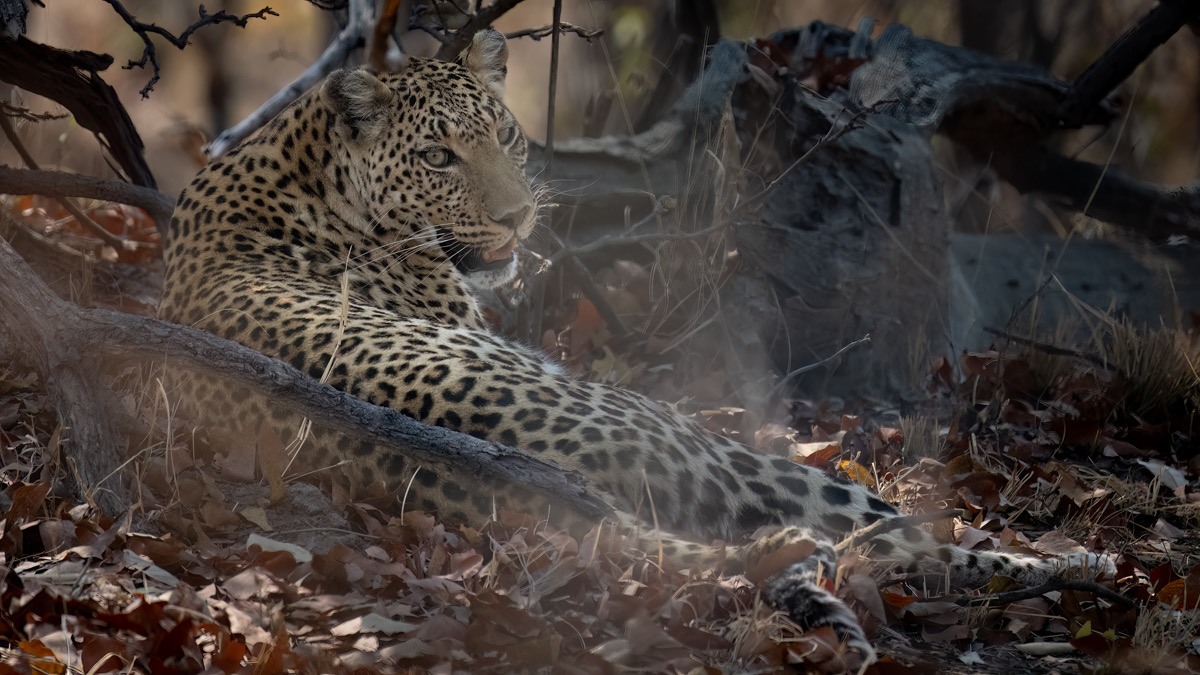

All five of the above images were taken just in the morning safari after the flight, before we arrived at camp for lunch. The trip is off to a fast start.
Our first afternoon started with lunch, some rest/nap/download, review images time, and instruction time, followed by the usual afternoon safari tea. Thom spent most of that time making sure everyone was up to speed and ready to photograph whatever we found, just as I'll be doing at next year's workshop. At 4 pm, we loaded back into the Land Cruisers for our afternoon drive. We spent until the local sunset in safari mode looking for animals before we headed back to camp for a shower, dinner and retiring for the evening.
We continued to have good luck finding subjects during this drive, but I’d say the most excitement in the afternoon for the group (especially the first timers to Africa) was spotting a trio of sleeping lions in tall, dead grass (below). As you can see, some of the photographic opportunities of the encounter weren’t stellar. The sun was setting, and we couldn't wait for the lions to wake. However, it’s always nice to spot three of the Big Five so early in the trip (the elephants and leopard in the morning, the lions in the late afternoon).

We did spot plenty of other animals for which I took the opportunity to get some images of some more common animals. On the first day, most people are willing [want to] to stop for more common animals, which I often don't take time to photograph. Later in the trip, that will become harder and harder after we’ve seen many more of these common animals and everyone wants a "new" excitement.


I'm a birder, so I also like to take all the opportunity to get decent images of all the birds that might be around. Today I saw a few birds I haven’t seen for multiple trips, as well as birds I sight more often. Different birds can be seen in an area due to visiting at a slightly time of year to catch migratory birds. Or you can see different species by changing areas, which causes the indigenous birds to vary. In September, for instance, the crimson bee-eater is migrating through the area:
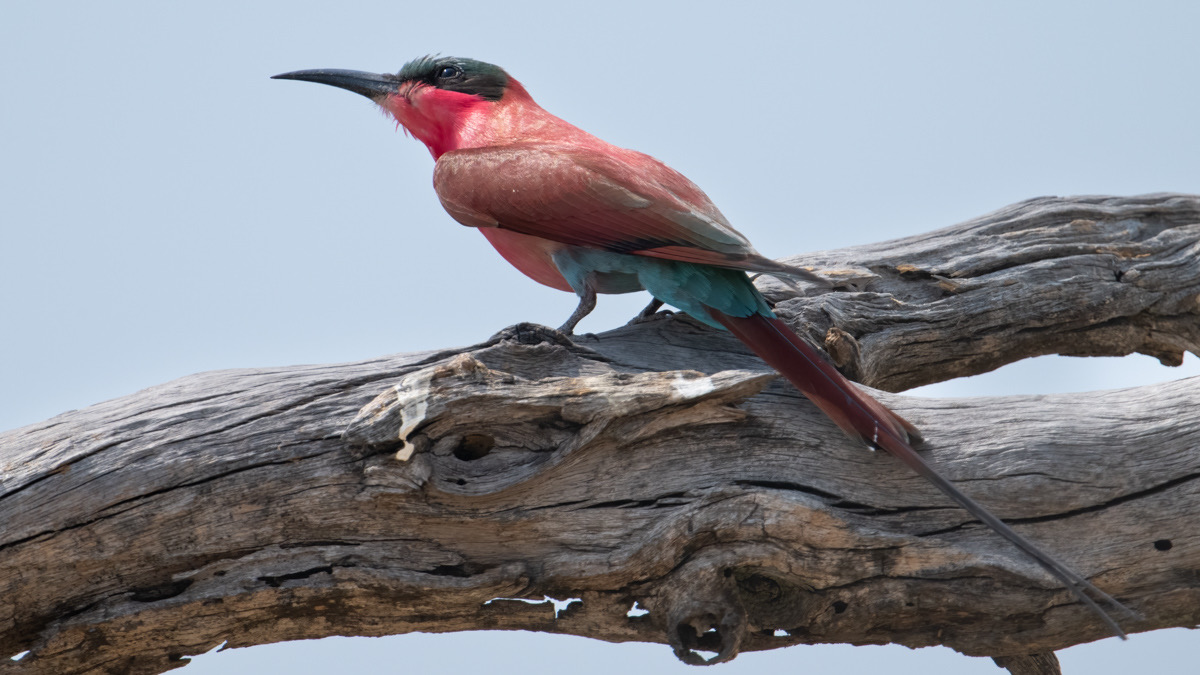
Red-Billed Ox-Peckers stick around, and only migrate on the backs on animals:

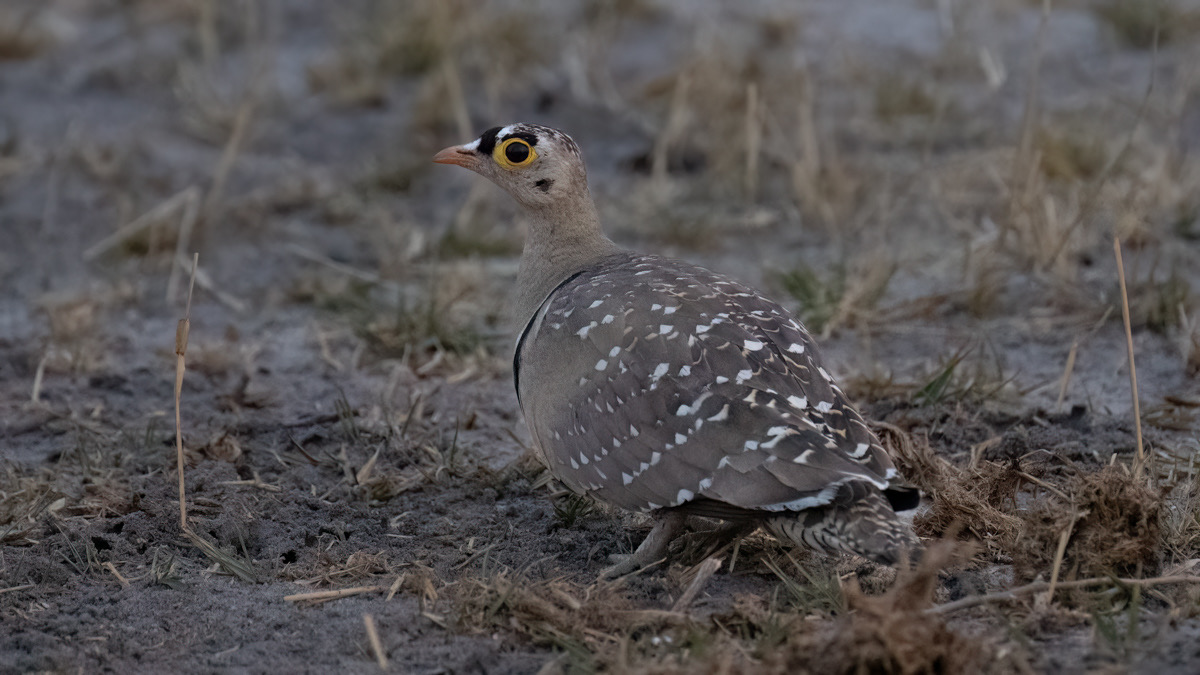
-------------------
Tony Medici is a photo instructor that specializes in Nikon equipment. He has been working with Thom for 15 years as the assistant instructor on all of Thom's large workshops. During that time, he has used a variety of Nikon cameras and lenses as Nikon completed its journey for its F-mount DSLRs ending with the D850. He has now continued with the Nikon line by using Z camera bodies including the Z9, Z8 , Z7, Z6 and Z6 II, and Z-mount Nikkor lenses, such as the 400mm f/4.5 VR S that was used in many of the above images. That puts him in an excellent position to answer specific question on Nikon cameras as well as general answers on Photography questions during any workshop that he might lead or help Thom with. Tony is also the Lightroom expert on a byThom workshop (Thom is the Photoshop expert), and helps students with organizing and processing their images.
Xakanaxa, Day 2 — "Day of the..."
Written by Tony Medici
[Additional comments by Thom are in italics and brackets, like this]
A quiet start in the morning
As we pulled away from camp at sunrise, the group I was with today (with some encouragement from me) decided to stop for sunrise photos. I was stopping for distant bird pictures that happened to have the trees and the sun as its view. So with the sun rising in the haze and dust, I took a quick picture, which also happened to have a Grey Heron perched in the tree. One thing that a lot of first-time safari folk tend to do is ignore the environment, but those photos tell us stories that just headshots of animals don't.
This was a short stop because everyone was hoping to revisit the small pride of lions we spotted yesterday late in the day. In the meantime, we stopped for what we saw when various animals attracted our attention. Here are a few random images I took while we did that. They included species including Waterbuck, Tsessebe, Yellow-billed Kite, Red-billed Spurfowl, Swainson’s Spurfowl, Common Ostrich and Impala. These are just a few of the species I spotted during the day, (plus 41 bird species today and an eventual 120 bird species for the whole trip). Due to lack of a convenient app, I don’t track mammals, reptiles or insects species.

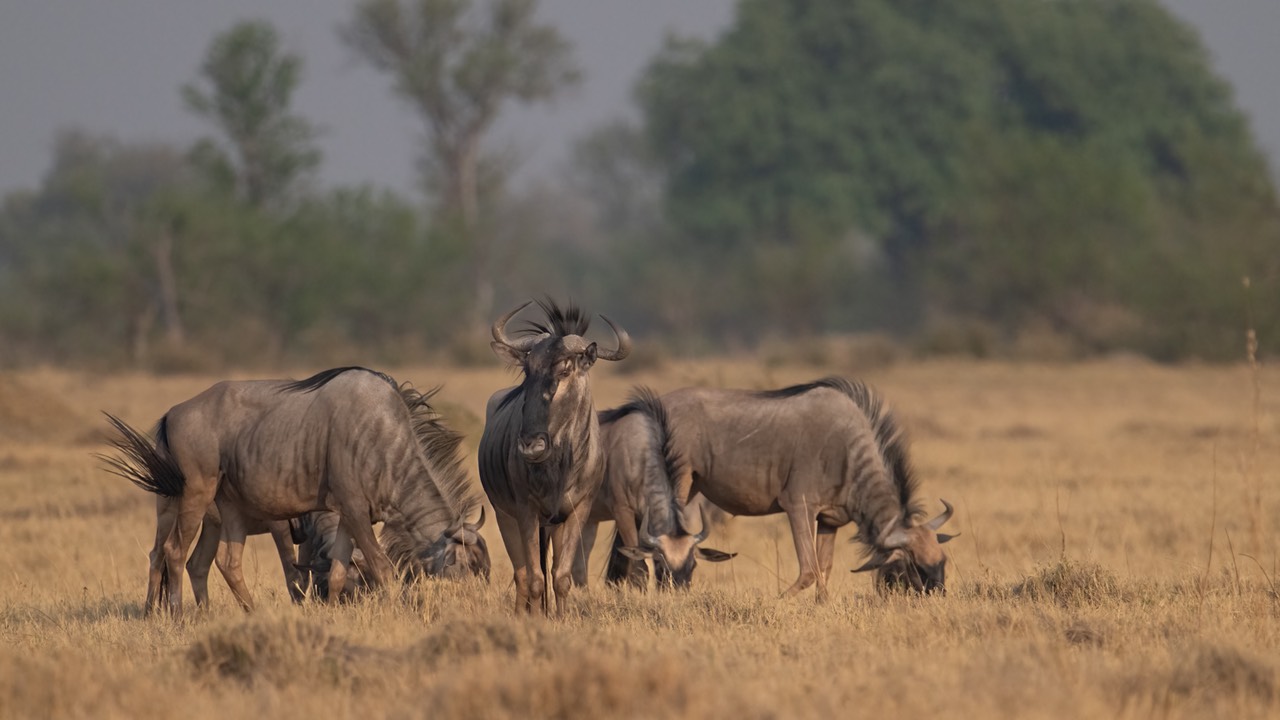
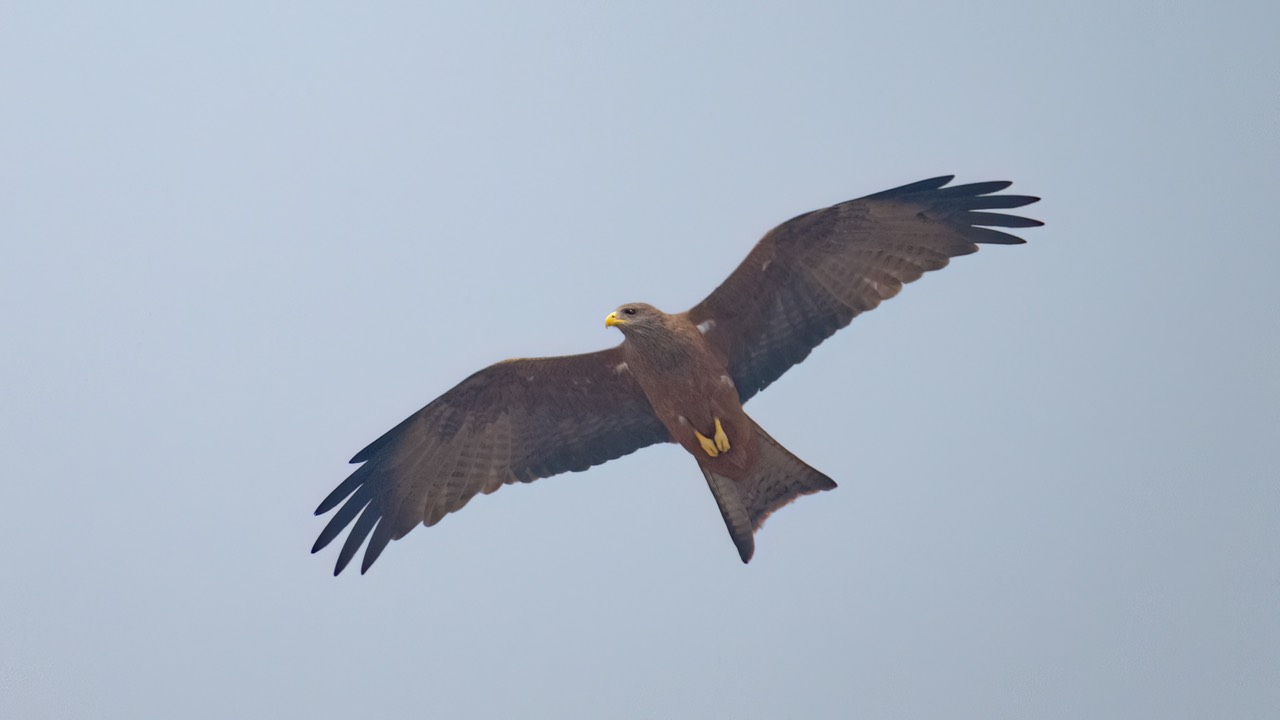



We never did find the three sleeping lions from the previous day. However, we weren’t out long before we found a different, nine lion pride.
A pride of nine lions on the move or on a hunt
Adding those nine lions to the three sleeping lions we found on the first day that were sleeping in the grass gave us a count of twelve individual lions spotted in just a few hours work, which left our group very happy with the sightings. During the initial contact, the Lions were active and playful and although they occasionally they moved toward prey, they never actually chased them.





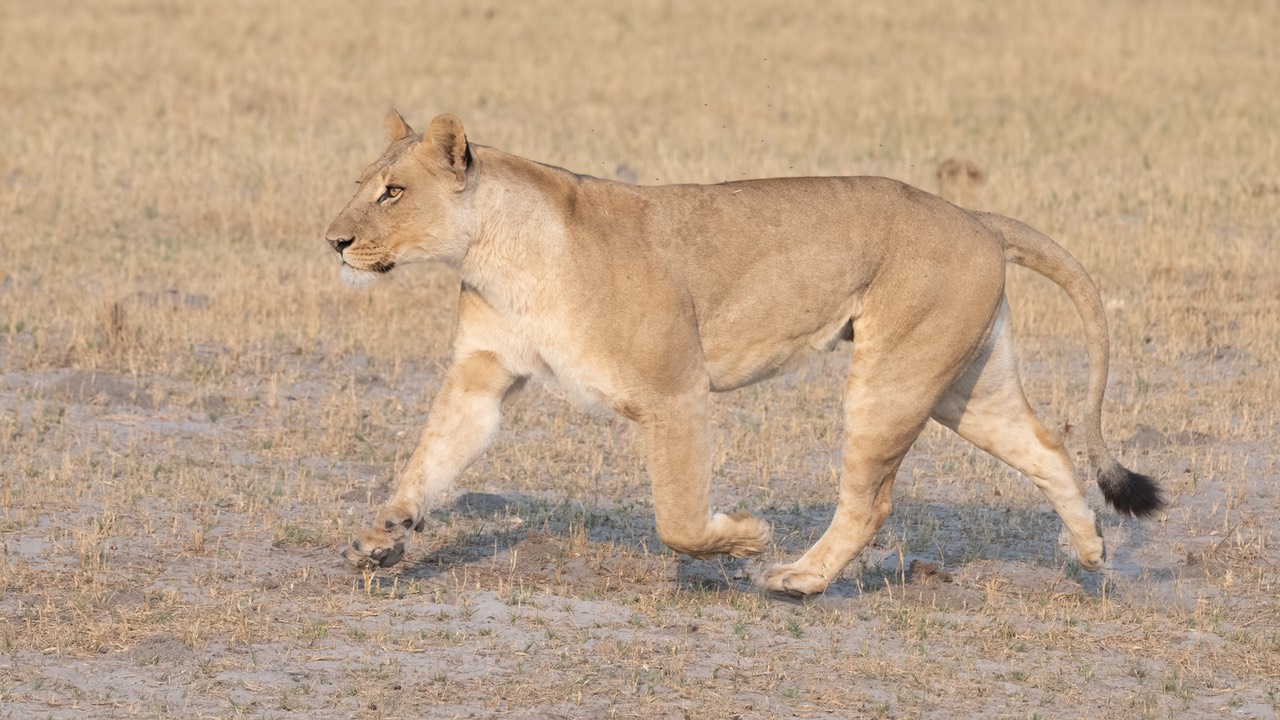
Turns out it was the day of the lions
We decided to leave the group of lions when they slowed down to rest, as the temperature continued to rise into mid-morning. As we traveled the area, just after our morning rest stop believe it or not we spotted another pride of nine lions. The guides were sure this group was not part of the first pride as we had moved a significant distance from that pride so we could stop at a scenic spot for morning break. So we designated it as the second pride of the morning. This group was actively eating at a kill [That would be another indicator of "different" pride; the two groups would have hooked up had they heard a kill from a portion of their pride]. We took the much messier images while the females continued to devour the kill. After spending time with them we eventually headed back to camp for our lunch and afternoon break.
The second (eating) pride also had nine lions, bringing our individual lion count to 21 for the trip in just over 24 hours! I don’t usually take lots of pictures of lions eating because most people I might show them to find them very gory. I try to take less gory images; here's a somewhat less gory image:

After our lunch, initial afternoon image reviews with Thom, a short break, and then the required British tea break, we headed back out at our usual afternoon start time of 4 pm. We spotted additional lions in this trip, but the guides were sure they were part of one of the prides we had already spotted, so we did not count these. The lion count for the day ended up 18 with the extra lions spotted more than once during the day. That count is worth counting as the Day of the Lions.
[I'll point out again that one of the benefits of a late season trip in Botswana is that the water sources force the animals to congregate closer together. In April, for instance, we do see some lions in Xakanaxa, but certainly not this level of activity. When the water is ubiquitous and spread out, so are the prey and predators. As the water dwindles down to just the permanent sources, things get concentrated to a specific area and finding both prey and predators is a lot easier. The guides have a word for this. They'll say an area is "pumping." I expect next year's September trip to be similar to this one: Tony will be teaching that workshop across three different permanent water areas, and I'll bet they'll be pumping...]
A lesson about Pre-Release Capture (30, 60, 120 fps)
The three highest frame rates for the Nikon Z8 and Z9 are 30, 60 and 120 fps [the Zf can do 30 in Pre-release capture]. All of these frame rates output only JPEG files and they each use different crops of the sensor to manage to shoot their specific frame rate and image size. I don’t often use these high speed rates because I’d rather produce raw files. Without Pre-release capture, the Z8 and Z9 top out at 20 fps recording NEF (raw) files [the Zf tops out at between 6.5 and 8.2 fps with raw and a live viewfinder, depending upon shutter type used]
Turning the Pre-release burst—Custom Setting #D3 on the Z8 and Z9—to either .3 second, .5 seconds or 1 second changes the way the camera operates when using Pre-release capture. Now the camera will be set to copy a burst before the shutter is pressed. The time the pre-release buffer is begun is with a half press of the shutter release. Starting focus (AF-ON) also starts the buffering.
Pre-release capture is used most commonly for trying to capture an event that you might otherwise miss due to your reaction time. Say you’re waiting for a bird to take flight; normally you miss the actual movement of take off due to reacting too slowly before you press the shutter release. In some cases, you might be so late pushing the first image taken doesn’t even contain the bird! Using Pre-release capture, you could be collecting images from up to 1 second before you press the shutter, which will also be saved when you finally press the shutter release.
If you run the numbers for each speed, C30 means as many as 30 additional frames, C60 is 60 additional frames, and C120 is 120 additional frames. All frames captured before you pressed the shutter release. You set the Pre-release burst time based on the frame rate you’re planning to use and how many images you want before the shutter was set [basically, you're telling the camera you're slow in reaction time or fast ;~]. I usually use 60 fps and a full second because my reaction time has gotten quite slow as I have aged. If I can’t afford to go into DX mode, I’ll set it to 30 FPS instead as that uses the full frame to capture the image and hope I got it. (Again Custom Setting #D3 is being changed to make that adjustment.)
Every new firmware seems to make a slight change to this mode. Read up on your camera to understand the full set of limitations. The Z8 needs to reset what’s being captured prior to release after 30 seconds. There is a warning indicator at the middle bottom of the viewfinder display. If the buffer is good and still being managed by the camera, the icon has a green dot in it. If 30 seconds have expired, a question mark will be there instead because the camera has stopped buffering the pre-release info [I believe this is partially done to manage sensor heat/noise]. The Z9 can have more than a 30 second buffering time [depends upon firmware installed], but keeping an eye out for the question mark is still a good idea.
To start, begin holding focus with AF-ON or a back button technique, or half press the shutter release. To begin taking images press and hold shutter for at least a second. Release shutter to end the sequence. [The "at least a second" caveat is mine. I've found that if you just tap the shutter release in Pre-release capture, you don't always get the sequence you're expecting. I've taken to telling people to hold the shutter release down for a bit, and I use "for one second" because that's something they can comprehend.]
During your wait to press the shutter, always monitor the status by occasionally looking at the pre-release capture icon in middle bottom of viewfinder. If the green light disappears, release your focus button and/or shutter release, and restart the sequence.
The above image of a Little Bee-Eater is taken at my normal 20 fps rate using raw output. It was entirely luck to capture, and it still wasn’t "lucky enough" since I usually just take short bursts and ended up not getting the bird/wing position I wanted. This was the eighth frame of a nine frame sequence. All of the seven prior images showed a (mostly) perched bird. The ninth image showed the bird had turned right and the head and the wing position was not good enough for a keeper.
The following sequence of a Crimson Breasted Bee-Eater I would break down into four categories. 28 images at the beginning were Bird on a stick photos (duration 1/2 second), 28 were Bird looking left images (duration 1/2 second), 21 were Take Off and Flight images (Duration 1/3 second) and 6 or more were unusable at the end of the sequence as the bird flew out of my framing. Breaking down the third category, I’m posting the 6th and 10th image. Fifteen of the 21 take-off-and-flight photos were good enough to have been keepers. (One consequence of "waiting for the bird" is that I accidentally took one of more sequences prior to getting the "good" sequence.)
When I’m switching in and out of Pre-Release Capture mode, since I already have Custom Setting #D3 set, all I do is pick a frame rate over 20. To turn it off, I switch the frame rate back to 20. [I go a bit further in my instructions: since the images will be JPEGs, you sometimes have to account for a slight difference in how the raw and JPEG files would be exposed. I'm often at +.3 or +.7 exposure compensation when taking raw photos, but there's no highlight retrieval possible with JPEG, so I have to dial that down. Tony always uses manual exposure mode, so he could just move the shutter speed up or down a bit instead.]
Xakanaxa, Day 3
Written by Tony Medici
[Additional comments by Thom are in italics and brackets, like this]
A quiet early morning
I can always tell when the morning is quiet compared to the start of other days. As I’m a firm practitioner of photograph what’s in front of you, I found I had a bunch of ubiquitous birds to choose from this morning while we were scraping to find bigger, and to most of the students, more interesting subjects.
Still it wasn’t a bad set of images I took, it just wasn’t the big five or any other more exotic animal people want to see.
The Burchell’s Starling as nicely lit up on its perch showing off its iridescence coloration which is much darker in bad light.

The Marsh Flycatcher is an erratic bullet which is almost impossible to catch in flight.
The Namaqua Dove presents a variety of different colors depending on age and sex.
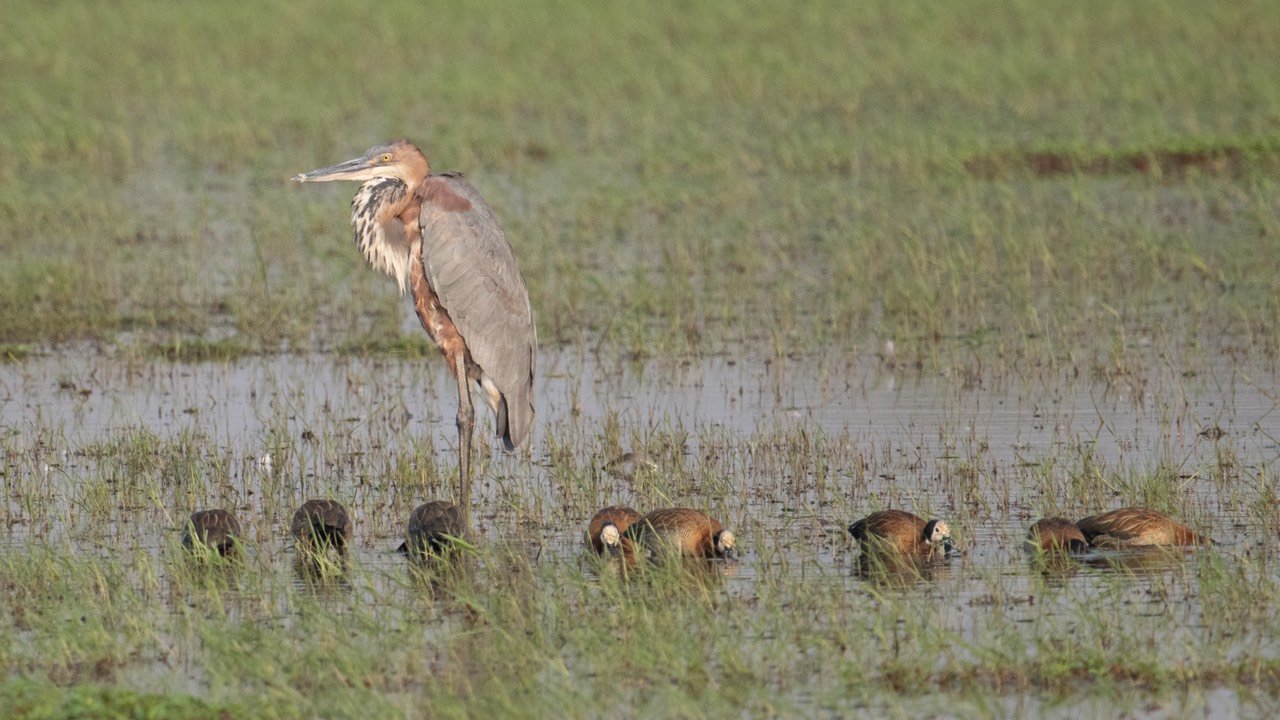
The Goliath Heron was a regular for the last three days since he likes it in the natural ponds just outside camp. The White-faced Whistling ducks swimming in the water and eating were a nice contrast to the Goliath Heron, which is the largest Heron.
A young Vervet Monkey standing what looks like very overly proud.
An elephant trying to cool as the temperature rises.
And lastly a Watted Crane that started a take off run only to decide to abort it.
And then...
A pride of 13 lions eating
This pride was about as messy as you get with lions. Most of the pride had finished eating and were resting under random bushes or in tall grass while a few were still eating. I could have taken pictures that were a lot more gory than what I’m posting here. I took few and skipped the worst things I saw. Lions on a kill usually gather Vultures too. I don’t think this kill had been dead for very long since I only saw Hooded Vulture around.

Lions on kill
Lion after eating

Hooded Vulture
The Afternoon
In the afternoon, Thom didn’t go out on the safari instead choosing to stay in camp for the afternoon. Going out every day can tire you out especially with the heat, and constantly teaching is a strain. [I'd also done a very intense scouting session just prior to this workshop, so I needed a bit of down time, otherwise I would have been running near continuously for over a week.]
Thom did give both vehicle’s occupants instructions though: come back to camp later in the afternoon with an image chosen by the occupants as the best image of the afternoon from that vehicle. These were my picked pictures in order taken for the afternoon. See if you can figure out which one I liked for Thom's game.

Hippopotamus out of water
Elephant Portrait
Giraffe
Grooming and Eating
Egyptian Goose

A Tree Hugger
[I should comment about this exercise. It isn't so much about picking the right image, though I don't tell the students that ;~). I use tricks like this faux contest to get students to communicate with each and talk about what makes one image good and another less good. Turns out with this group of six, my trick had exactly the right impact. Both groups were still seriously discussing their images and the merits of them well into dinner.
The other interesting thing about making "best image" choices also reared its head in the discussions. When it's your small group doing the discussion, sometimes you start second guessing yourselves and try to figure out what I'm up to and what I want to see (don't, that's a waste of time ;~). More than once I've seen a group pick an image I didn't feel was the strongest, and when I tested that by showing all the examples to the other group(s), they agreed. This brings up the "we're all our own worst critic" problem.
My intent on workshops—and Tony buys into this too—is that we're there to discuss and improve our photography. That isn't just about technique, but also in how both we and others perceive the photos that we create. There's no one "right" way to take photographs. It isn't about aperture, shutter speed, ISO, or anything else technical. The technical decisions should inform your aesthetic decisions. We've all seen great photos that could have been captured better. But we also have all seen far too many photos that are technically excellent but aren't interesting. The goal, of course, is to do both.
As I observed the two groups and listened to their discussions, I could see that's exactly what they were trying to figure out, which was the intent of my little charade.]
It’s not really shooting fast, it is being prepared to shoot.
How do you photograph so quickly? Some people say to Thom and I: "You always seem to get the image while I’m always missing it."
I don’t take photos quickly at all. I simply pre-set everything so that under "normal" conditions, I’m always ready to press the shutter release immediately.
What does that mean? Well on Safari I set the camera so that I can immediately photograph something once I get the camera in focus. During the day, when the exposure remains consistent, I set the exposure manually for isolation on a single subject. That means if I encounter a single subject attraction that is in the sun, I don’t have to change anything about the camera settings when the encounter starts. That means I could be taking images as soon as the vehicle halts and I can get a good focus on the subject. Sometime that pays off because we spooked the subject, it moves within seconds of that first image being taken and had I not taken it on stopping, I would have no image at all. This will also, mostly, work in aperture priority mode though you might have problems with certain color subject. [I'd also point out that you can get focus "close" by having it set to a distance you anticipate seeing a subject at. The current cameras are incredibly fast to focus if they don't have to move the lens from the closest focus position or infinity to a subject that's in between.]
In the evening or early morning, an automatic exposure mode might get you there quicker since the light is constantly changing. Though you can still be ready using an manual mode if you are regularly checking the exposure meter to make sure it where you want it to be.
If you are photographing with two cameras, you need to make sure both are being updated between animal encounters.
[With new safari students, I also spend the late afternoon saying to them "what's your shutter speed? Do you need to increase your ISO?" as the light wanes. In the early morning, it's the opposite refrain. Tony's point here is a good one: be prepared for what you want/expect to happen. Don't wait for it to happen to make settings.]
Into the Okavango Delta, Day 4
Written by Tony Medici
[Additional comments by Thom are in italics and brackets, like this]
A Travel Day is one of two days on this trip were we have to leave camp and get to another location by nightfall. Today we will travel from our camp in Xakanaxa by Land Cruiser to reach a public dock, and then travel by boat to arrive sometime in the late afternoon at Xugana Island Lodge. A picnic lunch, which we bring with us, is held on an island deep in the delta in the middle of the boat trip.
The Story about The Tree Hugger
Following up on yesterday afternoon's Thom challenge: the only thing I did was take the picture. I didn’t spot it and I didn’t name it. [One of the things I tell students to do is name a photo in their head as they take it. This gets them away from taking pictures of nouns and taking pictures that communicate something.] The group I was in decided it was our best of the afternoon. [I'll point out that they were still talking about that well into dinner, debating the merits of several images. Which, of course, was my goal.]

It turns out that both the spotting and the naming were done by our driver/guide Adam Hedges. All he said was “Tree Hugger” I don’t even remember if I saw him point at the elephant but I did see the picture when I looked back up. The camera was instantly up, I adjusted its zoom—this was the 100-400mm—and I took a short burst at 20 fps. Only the first two images got the tree hugger pose (1/10 of a second) and by the time the sequence was done, the elephant was off the the tree. One other person got some shots, but mine were judged to be better. He never showed me what he actually had taken but I suspect it was what I took later in the sequence.
So also following up on yesterday’s post, I wrote the "be prepared to take images" advice because it's the only way to get some kinds of images. Moments in time are very ephemeral. The above image was taken right around sunset and my last checking of my manual exposere was good enough for the image to work.
Yes, my image was the picked image for the afternoon from our vehicle. The other image from our group that was considered was a herd of Cape buffalo. Once again I miss another large herd of Cape Buffalo [That's what happens when you're always looking at the birds ;~]. The image picked by my group was a very nice image of a lot of buffalo. We had luck that our guide spotted both situations and even named the winning picture. But that's one of the reasons why we use veteran guides who've worked with Thom and other photographers before: they start keying into what we want to photograph. [Adam is the founder of Capricorn Safaris and has been leading trips in Botswana for 40 years now. Indeed, he was the lead guide on my original Botswana trip with Galen Rowell back in 1994, and I've used his company ever since for our workshops.]
Traveling to the dock
We started at our normal morning departure time with bags packed for what we needed to sleep two nights at the lodge. That lets the camp crew bring your large bag with them on the mobile camp transfer instead of loading them on the boat and later on the Cessna Caravan we will travel on during our next travel day.
In the early morning it was generally quiet with us seeing a few things.
We saw a Tsessebe on alert. This is the fastest Antelope in Botswana. Despite all the lions around, we never saw one really running, so you'll have to take my word on its speed.

An African Fish Eagle looking for a meal. You hear these birds long before you see them, as their calls are very distinctive.

A Red-billed Spurfowl in a nice walking pose. Generally, you want a foot off the ground to imply walking.
A Hamerkop walking in low water. Be sure to get the complete reflection when working around water! These birds build enormous nests.

Our first male lion as we found him (middle of road).

Since we had not seen a male so far on this trip, he had to be another unique sighting. This makes for 22 unique lions seen so far on the trip.
A little after we arrived on scene, Thom and Adam arrived with the other students. That presented some new photo opportunities:

We also saw at least one female, which the guides indicated was a member of one of the four prides we had seen before. This brings our total with three and a half days to 35 lion sightings total, and 22 unique ones.
African Wild Dogs on Day 4
We also heard about a dog pack over the radio from a friendly Lodge guide. It was supposed to be out of our way, so we had to rush down to Second Crossing, where they had previously been spotted. Eventually we found them not far from the dock area we were to use. The pack was at least seven dogs (there probably were a couple of others in deeper bush we didn't see). They were resting, which is typical for the middle of the day, but they provided a few minutes of enjoyment prior to getting on the boat and seeing what the water might bring.


The Boat Ride
It was time to abandon the dirt tracks and load up onto a small flat-bottomed boat. We'll be heading up river through multiple lagoons to our eventual goal, Xugano Lodge.
One thing about finding elephants in the river channel is that you end up close to them. The 100-400mm feels like a very long lens when that happens.
But the primary targets on the river tend to be birds.

Little Egret


African Darter

Nile Monitor lizard
All the above were all taking while traveling up river to our lunch spot. After our picnic lunch, we continued on, and found an active rookery, where we had plenty of BIF (birds in flight) practice.
Yellowed-billed Stork

Marabou Stork

Marabou Stork Portrait
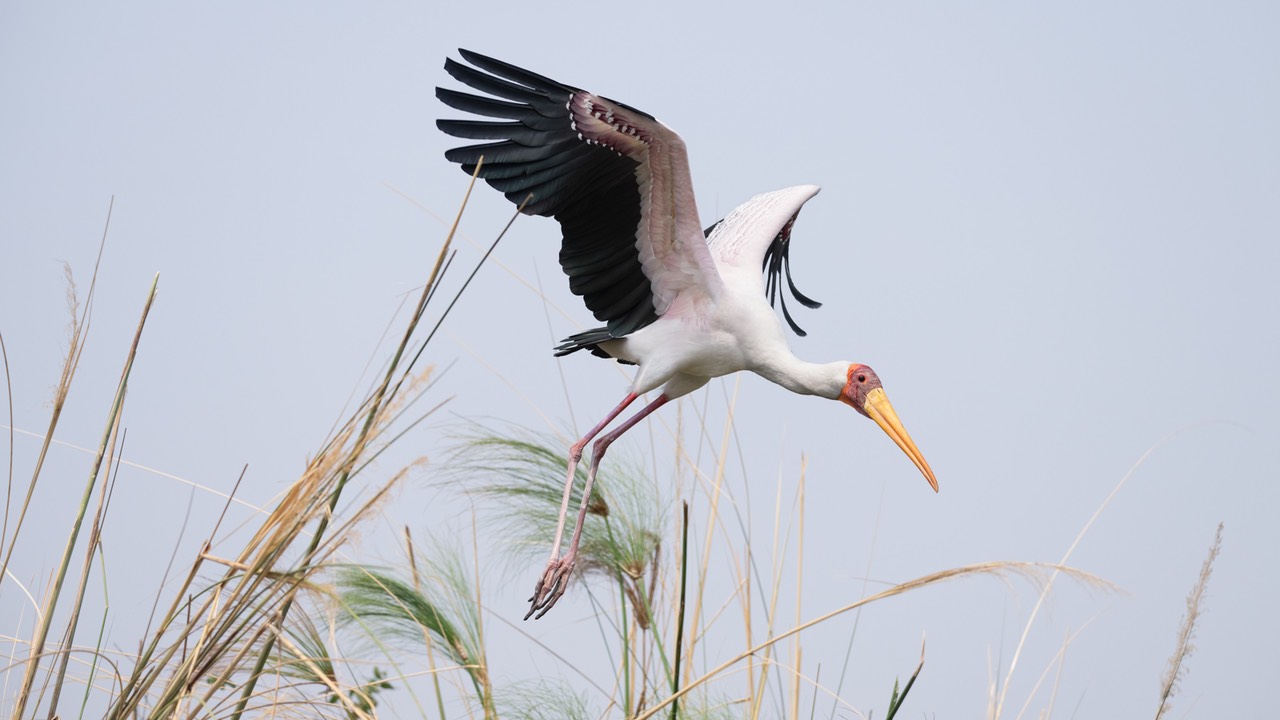
Yellow-Billed Stork

Great White Pelican

African Openbill
The only small disappointment for our boat ride today: we saw no Malokite Kingfishers.
[As often happens on the long boat ride to Xugano, we arrived late, almost at sunset. We try to spend as much time at active sights like the rookery as we can, but that puts a real strain on both our boat driver (who has to get back to Xakanaka while he can still see) and the lodge, as we're already into dinner time by the time we get settled in our rooms and cleaned up.]
Xugano Island — Day 5
Written by Tony Medici
[Additional comments by Thom are in italics and brackets, like this]
The schedule of activities runs a bit differently at lodges than it does in the mobile camps. At Xugano—pronounced Tsu-gawn-o with a click at the start—we wake up a bit later since we can’t travel between buildings unguided when it is dark out. A quick breakfast is followed by the chosen morning activity. Once that activity is completed and you’ve returned to the lodge, we have brunch followed by free time during the heat of the day. We gather again for tea time and then go out for another chosen afternoon activity until sunset. You’ll then be given a choice between returning to your room before dinner or waiting for dinner in the common area. If you do return to your room to freshen up, you schedule with a guide to come get you for dinner since the lodges don't want you to travel outside the common area by yourself after dark.
This morning I decided I would skip the morning activity in favor of working on some images and working on possible topics for the blog. I understand I missed a guided walk and a slow boat ride safari and that both were great. I’m ok with missing them since I needed a break and I needed to work on ideas for the blog. Everyone needs some downtime during the trip and Thom and the guides will remind you of that during the trip. On any day that isn’t a travel day, you can chose to skip an activity by staying in camp.
[I, however, did go on the morning walk and boat ride. Here's some of what Tony missed (all taken with my APS-C camera):

We took two boats out deep into the reeds to a remote island, where we walked a little over two miles according my Apple watch. I love these walks because it's a very different experience from driving around looking at things; you feel like you're part of Africa on these walks. Moreover, you can see and photograph just about anything in the environment, and take your time in doing so:

(The previous time we were in this exact place, there was a big male lion sitting under that tree in the background ;~).
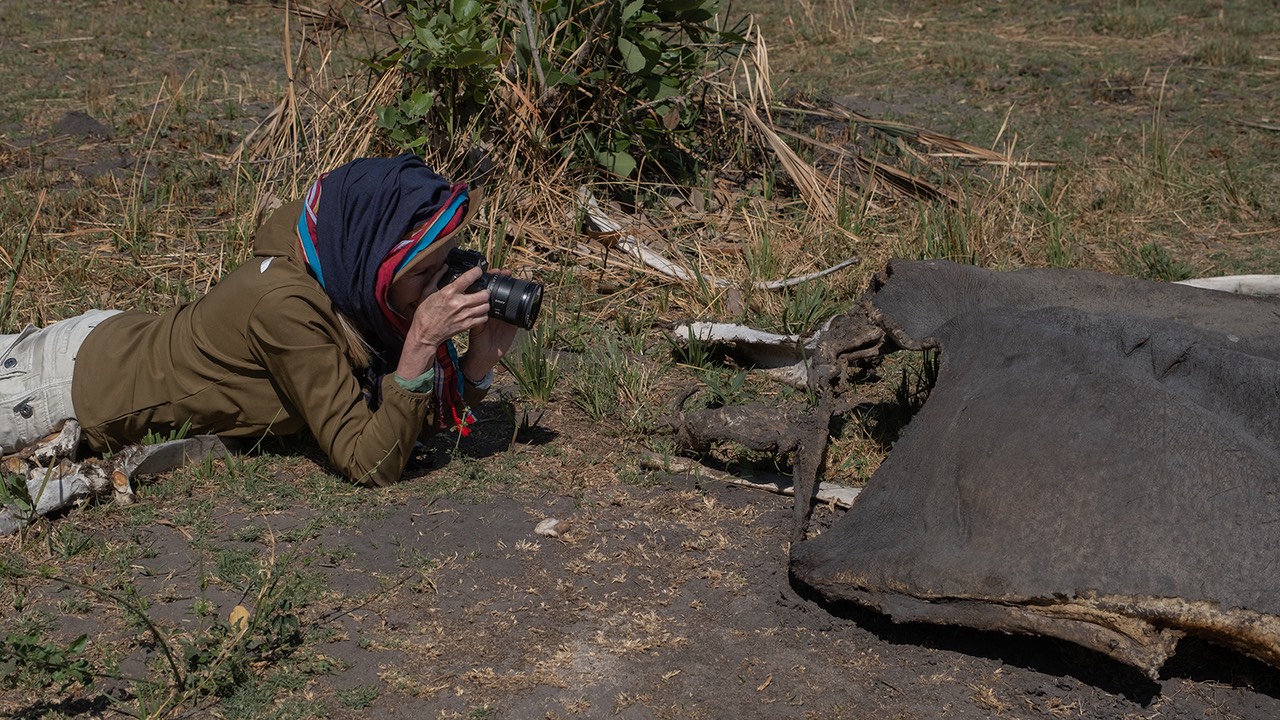
After our walk, we decided to attempt to get to the second rookery in the area, which you can't always do because the water levels sometimes preclude getting even our shallow hulled boats through. We slowly worked our way there, though, and ended up with more bird mating activity. I'll keep this G rated, but we saw pairs of several species of birds doing their rituals and nest building.

One thing about being in the narrow channels of the delta is that this also increases the likelihood of finding the elephants in the water, too:

The afternoon activity was another boat ride that about half of us decided to go out on (Thom took the afternoon off; we often do this one day of trading off time on our longer trips). As with the morning ride, the ride gave us lots of opportunities for photography, and we spent most of that time looking for and finding the birds that inhabit the reeded delta.
On the boat I used a Nikon 400mm F4.5 and a 2x converter on a Z8. I also had a Nikon 100-400mm on a Z9 as a backup.
A Pied Kingfisher in flight.
A Malokite Kingfisher in the reeds fishing.
A Nile Monitor Lizard in the reeds sunning.
A Squacco Heron scared off by the boat approach.
A Malokite Kingfisher in the reeds.
A flock of White-faced Whistling Ducks.
A juvenile Red Lechwe.
A Green-backed (Striated) Heron by the water’s edge.
A White-fronted Bee-Eater on a reed.

A White-fronted Bee-Eater right after take off. This was taken using pre-capture mode at 60 fps.
A Goliath Heron in late afternoon light.

A Malokite Kingfisher right after take off.
We probably saw and photographed a couple of dozen different bird species today. But rather than chasing a higher number, both in the morning and afternoon we tended to concentrate on finding good habitats that gave us better access to specific birds.
September is an interesting time for birds in the Okavango, partly due to the nesting that's going on, partly due to the migrations that are being done through the area (in both directions!). The rains start soon, and that's one of the things that drives all this bird activity this time of year.
Savuti is Cat Country — Day Six
Written by Tony Medici
[Additional comments by Thom are in italics and brackets, like this]
This morning we will be traveling by plane to Savuti in Chobe National Park so we can spend two days in that area. This morning’s activities include getting up late for once, eating a full breakfast and then arranging to get our luggage to the common area so that it can be transported to the landing strip before the plane arrives. Then we’re transported to the strip by boat ourselves so that we arrive prior to the plane landing. These small Cessna Caravans charge by the prop hour, so we want the plane to spend as little time as possible on the ground.
Traveling to Savuti
The flight itself is about a 45 minute straight line to the Savuti airstrip, were we meet up with our vehicles. Once there, we fish out any camera gear we want to use on the leisurely drive back to our newly set up mobile camp. I ended up with a good set of images from the drive back to camp as you can see here.

It’s rare that you see a cooperative Roan Antelope in the Okavango. I have very few images of Roan’s that fill the frame so I consider this an excellent start to the drive back to camp.

An adult Yellow-Billed Kite in flight.
A Spotted Thick-Knee walking in the brush. As you might be noticing, the different bird species we're seeing are adding up quickly. On a typical trip we'll generally identify 150 or more species, and be able to photograph most of them.
A female Leopard in the rocks. Thom complains a lot about not seeing any leopards on Leopard Rock, but this year we managed to find a female who had stashed her cub back in a quasi-cave under one of the bigger rock overhangs.
Eventually the cub woke up and became sort of visible to us. However, she picked a spot where Land Cruisers can't get good access to, so photographing the pair was exceptionally difficult. We were still on our way to camp, so we settled for a quick photo or two and will return here later to see if we can get better images.
Once we arrive at camp, we have our usual camp-prepared excellent hot lunch followed by our usual free time. Thom works with individual students reviewing images during that time, but it's also a time for recharging and reorganizing equipment, showering, or napping. Tea time at 3:30pm is followed by heading out on an afternoon drive starting at 4:00pm.
Some Big Cats
Savuti is know for its cats. So that's what we're looking for as we head out. Fortunately, the afternoon drive went just as well as the short trip from the airstrip into camp. We knew where we would likely see the Leopard again since we knew where one of her dens was so we left camp with high expectation. Those were mostly fulfilled when we came across another large pride of lions before ending the day at the den. Also, as usual, we took the time to photograph more birds along the way.
Early in the drive we came across a Brown Snake Eagle high in a tree.

A foraging Helmeted Guineafowl. The guineafowl are called the Chicken of the Sand in Botswana, and ubiquitous. They also provide an excellent early warning system for cats...

I mentioned the large pride earlier. Here's the youngest lion resting in the road and halting our ability to get to the rest of the pride momentarily.
Fortunately, young cats don't rest long and are curious. His brother soon came to see what we were doing.
After spending a great deal of time with the lions—the parents were mostly resting, so other than child play, not much was happening there—we decided to circle back to see what our leopard lady friend was doing. As is typical, she'll spend time away from, but still protecting, the actual den site, and this gave us the chance to get some excellent photographs of this magnificent animal.
Lions and Birds — Day 7
Written by Tony Medici
[Additional comments by Thom are in italics and brackets, like this]
We’re back to our “mobile camp” schedule with a wake up call before first light so that we can be in the vehicles, ready to go, and leaving camp at the earliest possible moment (the park restricts the hours you can be out of camp). Even though the light is just starting to show, during the first hour we stopped for several sightings, including this Pearl-Spotted Owlet.
In late September Savuti is very dry. Savuti currently has no flowing water in the area, and the yearly rains have all long been used up. Without water, few animals would still be grazing in the area. However, the park service uses solar powered pumps to create water holes that attract enough animals to keep this area open for safaris during the dry season. Currently, one water hole is still pumping fresh water to allow animals to use the area.

[Many don't realize that the cover photo on Fran's Lanting's Okavango was taken at one of these pumped water holes. The park service in Botswana established the original water holes partly to keep the wild animals from wandering out of their huge protected area into villages, farms, and hunting areas that are outside the park border. Coupled with watering holes at a few lodges in the area, this was enough dry season water to keep the non-migrating populations from wandering into areas the country didn't want them in.]
That means we know where most animals will be since all need water to survive. This morning we been driving through an area called the marsh (which is a marsh during the rainy season but is dry now) where most of the prey graze since it is hard for the predators to hide in the open, flat area. This makes it slightly safer for the prey so that’s where we started our search for animals this morning.
The Pride on the move. (Heading for the Water Hole)
We found the pride on the move in the Marsh area. This is a good size pride with about 15 lions in it. Their eventually ended up at the water hole for nice drink.

With so many lions in the area, the rest of the animals were skittish. They tended to run completely away from the water hole and back in to the bush when the lions came to drink.
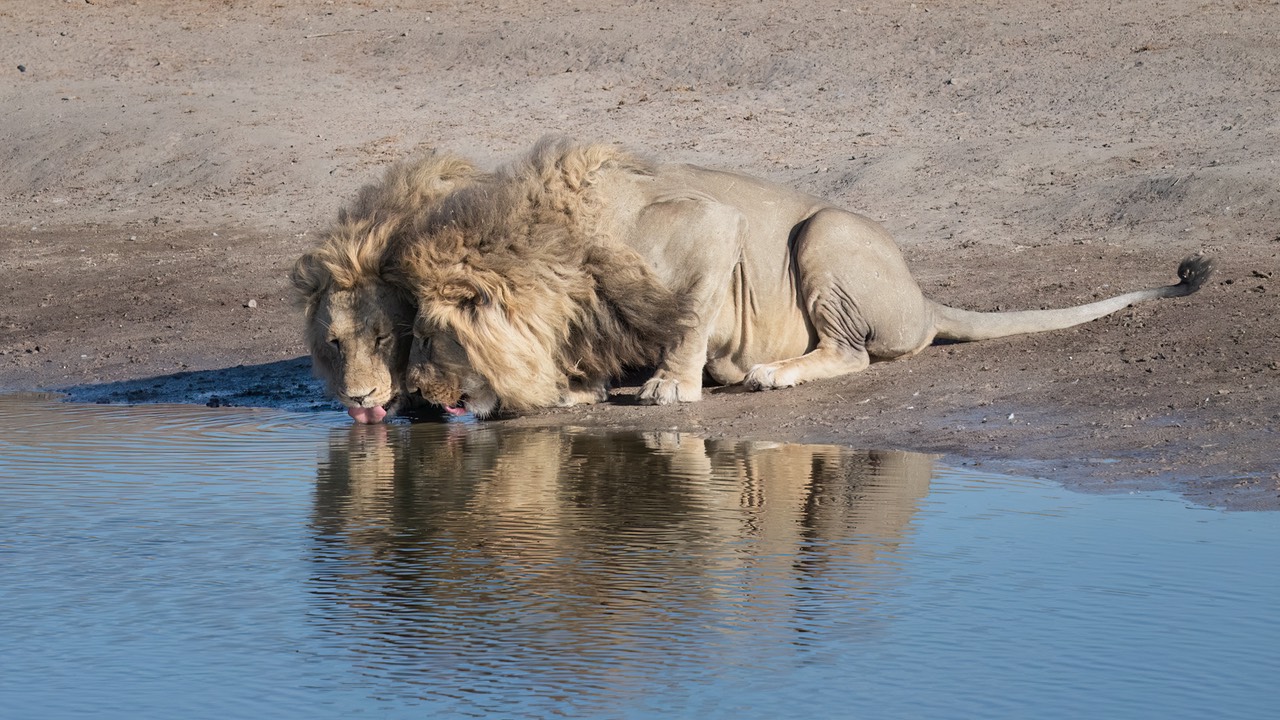
And, of course, if there is water in the area, we’ll also find lots of birds.
Burchell’s Sandgrouse
Red-Billed Oxpeckers
Lilac-Breasted Roler
The day ended pretty much like the morning started. Except at this time of day, elephants dominated the water hole.
As in the morning, a number of different animals species were hanging out around the water hole waiting on their opportunity to drink while not upsetting the elephants. Some industrious predators even mange to catch dinner while in the area.

Black-backed Jackal headed for the den with his dove dinner.
Headed to Chobe — Day 8
Written by Tony Medici
[Additional comments by Thom are in italics and brackets, like this]
The morning convention at the water hole this morning.
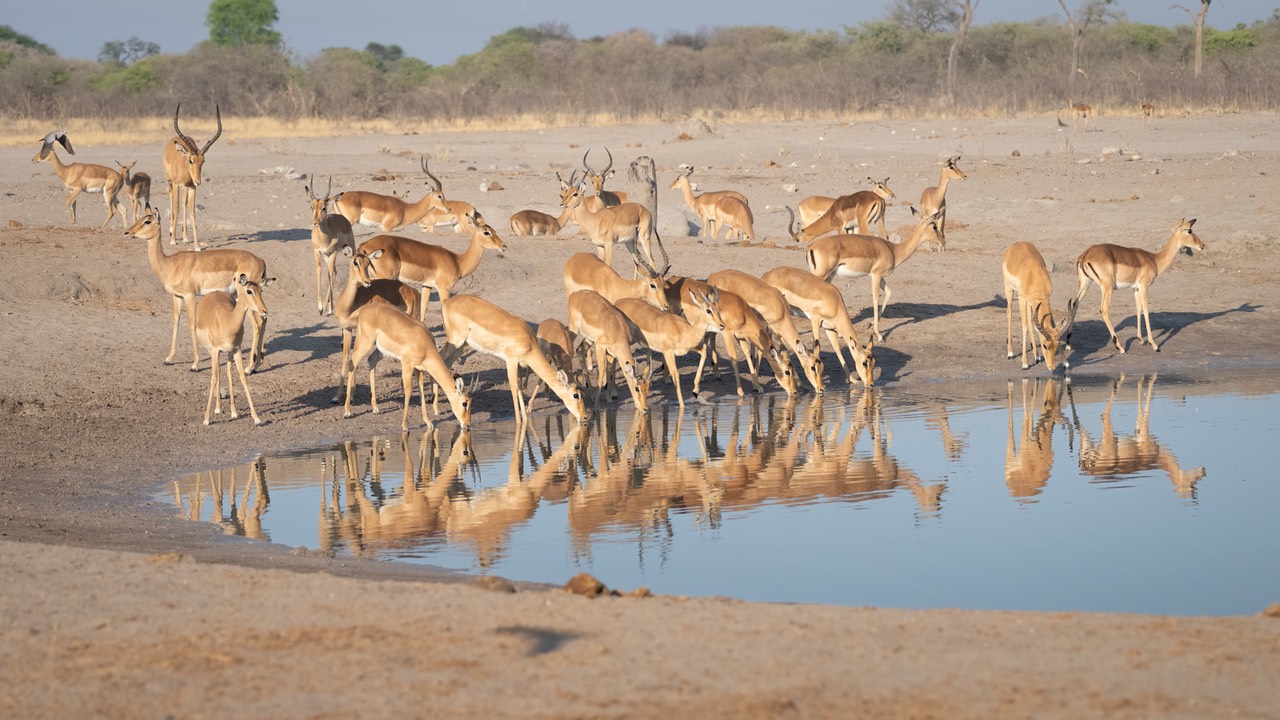
Moving from Mobile Camp to Mobile Camp
Last night at dinner, we were reminded that this morning we would be taking all our gear and luggage with us in the safari vehicles during the drive today since we will be leaving this morning from our camp in Savuti and arriving tonight in a totally different location within Chobe National Park. The crew had started packing parts of the camp during yesterday’s afternoon drive with the packing of the dining tent, which leaves the dining table open to the stars during diner. While we were eating dinner, all the tent showers were also taken down to get them ready for travel. As soon as we depart camp, the crew takes down the final bits and packs everything else remaining in preparation for the day's quick move.
Our Safari plans are to hang out in the Savuti area until we get the radio message that the truck is packed and they are on their way to the Serondella area of Chobe National Park, which I will refer to as Chobe. That will occur between 2-3 hours after we left camp so figure we’ll spend 3-4 hours in Savuti this morning prior leaving the area and heading for Chobe. That leaves us plenty of time prior to leaving Savuti this morning to visit the marsh area and the water hole along with stopping to see some historical rock paintings before driving north.
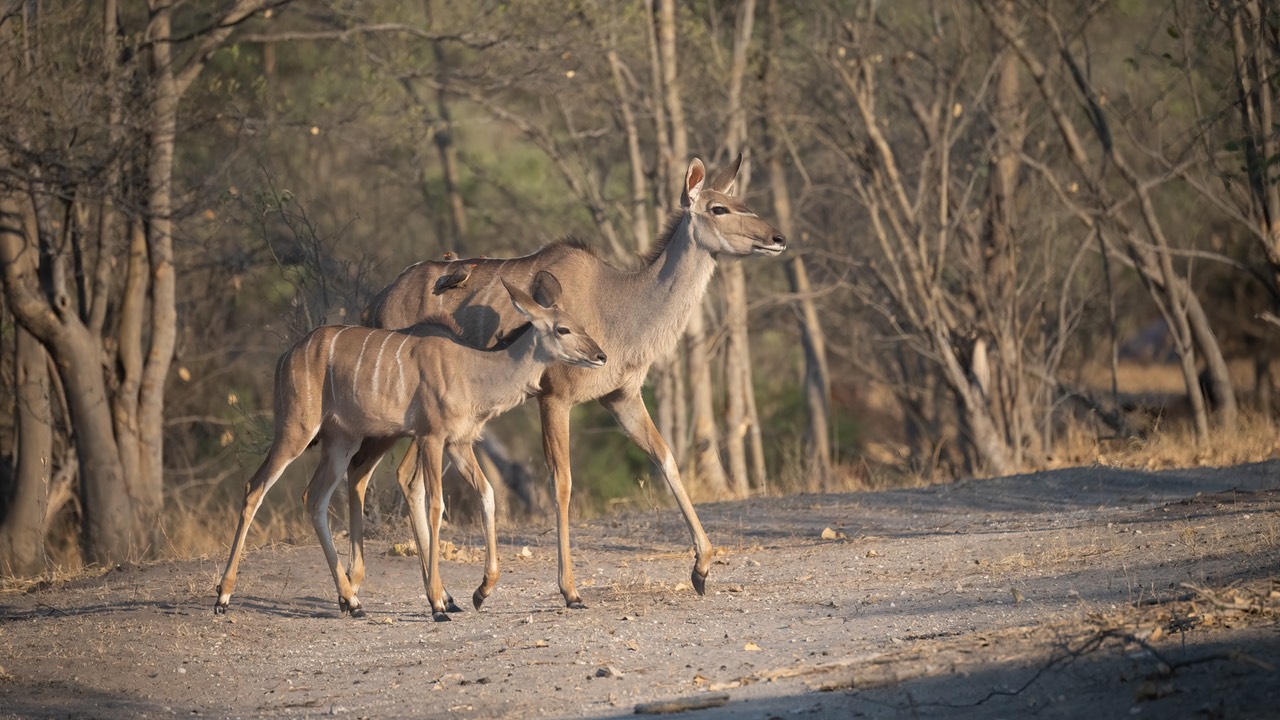
A mother Kudu and her young with some red-billed oxpeckers along for the ride.
A Southern Ground Hornbill with their breakfast.

Burchell’s Sandgrouses flying around the water hole.
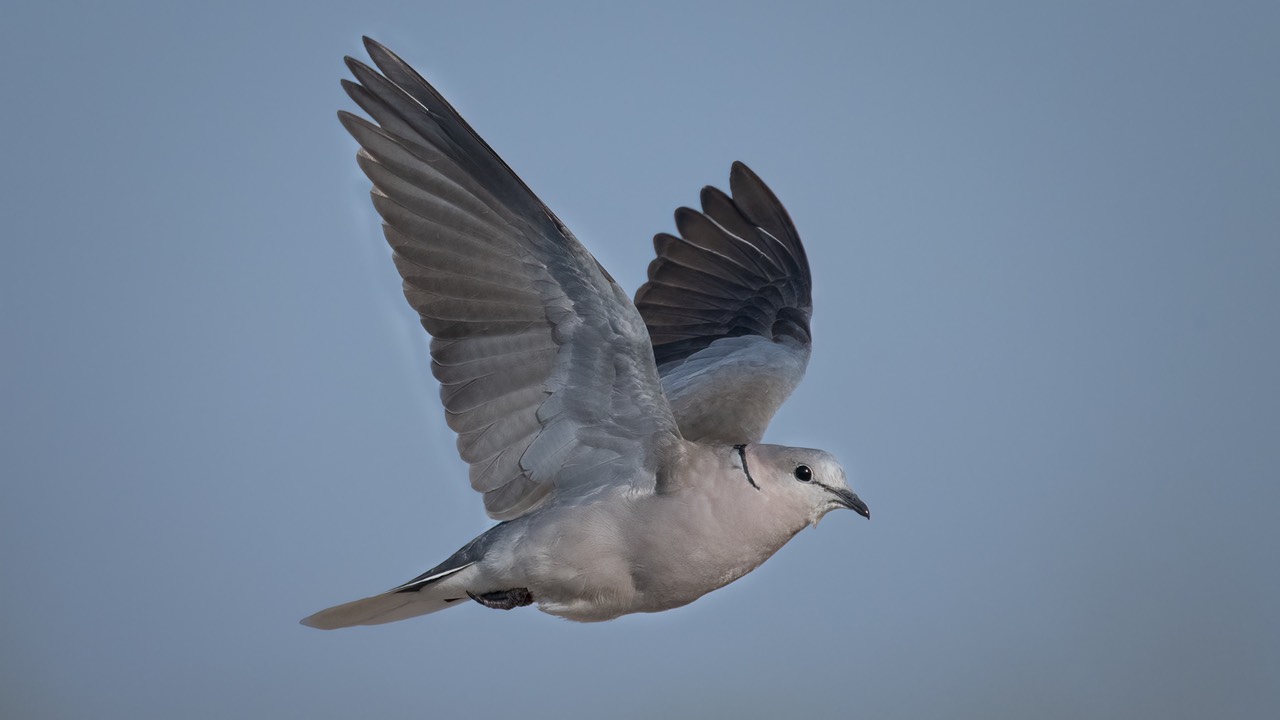
One of the many Cape Turtle Doves flying around the water hole. Do they coo bots-wa-na, drink-law-ger, or work-hard-er? No one knows. But their sound is ubiquitous throughout the day.

A Senegal Coucal on the move next to the water hole.

My version of the waterhole line-up shot. This one of Impala’s, with some helmeted guineafowl thrown in for variety.

A yellow-billed kite landing near the water hole. Note that all the other birds left the area as he came in. It's one thing to eat breakfast, another to be eaten for breakfast.
A Black-Backed Jackal goes for THE KILL!
That last one got me really excited as I’ve never gotten an image of a kill in progress before. I usually end up with something like the Hornbill image, where the prey is already captured or dead. Unfortunately, as I was saying “I got it” right after taking the image, someone else in the vehicle was saying “It missed it”. I eventually realized that he was talking about what I just said.
After the fact, in looking at the events leading up to that image and beyond, I realized that indeed the hunt had been unsuccessful.
I noticed a Jackal actively chasing doves so I started following it. The time of this first image was taken at 07:47:37 am.
You can see in the next few photos, it was actively hunting.
Botswana - Chobe - Savuti -20230929-0747-AnthonyMedici-Z90_4539.jpg
Botswana - Chobe - Savuti -20230929-0747-AnthonyMedici-Z90_4547.jpg
Botswana - Chobe - Savuti -20230929-0747-AnthonyMedici-Z90_4557.jpg
When I saw the lunge and snap of the jaws, I started a burst of the action.
My reaction to start the burst was a little slow. I seem to remember seeing more than what I ended up with for images. However, it is clear to me that I would have gotten nothing if I hadn’t actively been following the jackal thru the camera at the time. The burst was at 20 fps with the first of that burst being taken 62 seconds after I started actively following the jackal with my camera. The first image in the burst had the dove coving the eye of the Jackal with a mound blocking part of the Jackal. So the second one seemed reasonable to me as the KILL shot with a bird flying away, a bird in the mouth and one eye visible.
It wasn’t until later that I went through the images that I realized that it was a failed hunt.
It took less than 1/2 second for the Z9 to take image 4567 to 4575. And although a lot of the action was blocked by the mound, it seems obvious to me that the bird with no tail came out of the jackals mouth and survived the encounter minus a lot of feathers. So 4575 might be the real story shot, a jackal with a mouth full of tail feathers and a bunch of feathers in the air.
[This sequence is pretty typical, actually. The most successful hunter in Botswana is the Wild Dog. They are said to have a 90% success rate, and that's mostly because they target larger animals and just wear them out chasing them. It's a stamina game, and the dogs always win. The Jackals are more like lions, in that they have a very quick burst speed, but tire quickly. If they manage to make the kill on a quick thrust, it will be successful, but if they miss the target even a little bit, the prey will get away. It's fairly common to see impalas with hind quarter scars and birds with missing tail feathers. That's what being even a fraction of second late can cost the burst speed predators. One of the primary reasons to be out on safari at the tail end of the season when it's dry is that it gives you many more chances to see these things in action. That's because water sources are scarce, and everything has to come to the water at some point. You tend to see predators nearby the water hole waiting for likely targets, with prey trying to stay aware of the hungry ones and keep just far enough away that they can make a quick escape.]
Continuing North
The crews message comes in earlier than expect as they indicate that they are north bound for Chobe to set up our new camp in Chobe. Soon we have finished up with our final images from the area, put the tops back on the vehicles to keep the sun off us and start our 4 hour (or so) drive to the northern parts of Chobe National Park.
We know we’ve arrived when we see the “Elephant crossing” signs.

We stop at an overlook location for lunch around 1 pm and see if we can get any images of the distant but plentiful wildlife.
[Tony seems to forget that at lunch we had so many pelicans around that it was almost impossible to photograph them. For instance, this:

From my far left to the river bank on the far right, this is the big-beaked chaos we saw. Want to photograph a pelican in flight? Well, there will be many wandering around in the water and shore behind them. Very challenging, to say the least.]
Once we finished lunch, we once again head north until the guides feel that we are close enough to camp to open the top back up and get back to safari mode as we head for camp. By 3:30pm or so, we back to stopping frequently as opportunities present themselves more frequently.

Remember it’s late September here in the Serondella area of Chobe, so there are some migrants that aren’t found further south. For instance, the Southern Carmine Bee-eater:

And it’s good to see we haven’t lost our luck in finding lions!
And to end the day, I photographed a male Giraffe as we drove up the track to camp.
Despite all the things to photograph, we got to camp about an hour earlier than usual which gave us a chance to learn the new layout of our camp, clean up and reorganize our stuff heading into our only full day in the Serondella area. All total, we were in safari mode for almost 11 hours straight, so it's been a long day, to say the least.
On the Chobe River — Day 9
Written by Tony Medici
[Additional comments by Thom are in italics and brackets, like this]
Today is our last full day in a mobile camp since we will be traveling to Zimbabwe tomorrow morning. Our day will be broken up into three parts today. A morning drive before breakfast, a drive to town so that the vehicles can refuel while we have a coffee stop at a unique Botswana road stop, and then an afternoon boat ride on the Chobe river.
The early morning drive I would call uneventful. Which is another way of saying that we saw lots and lots of things, mostly further away than we’d like, while nothing stood out as really memorable in my mind. After all, that’s the way you tend to look at drives that don’t bring you up close to what you really want to see. Or when you compare it to other days that have had lots more action during the same period of time.
And yet I have pictures of two Red-billed Spurfowl fighting,

Botswana - Chobe - Serondella -20230930-0637-AnthonyMedici-Z80_9514.jpg
a Goliath Heron by the river,

a portrait of a Swainson’s Spurfowl,

a Southern Carmine Bee-eater in a tree,
a Zebra and a foal, plus a male kudu on the road up to our camp


All these were taken before breakfast at 8:30 am. Some people would consider what I did get, mostly birds with a sprinkling of larger prey animals, as something to cheer about, while some would be disappointed they didn’t see anything interesting because there wasn't any predators. I consider it a reasonable start to the morning or a typical morning in Botswana.
After breakfast, we then prepared our gear for the rest of our day away from camp and headed out around 10:30 am for the ride through the park into town. Again not really anything I’d call eventful and yet I got these two images of a baby elephant in the open. (Usually the babies are well hidden in the mass of legs of the larger elephants around it which protects them):

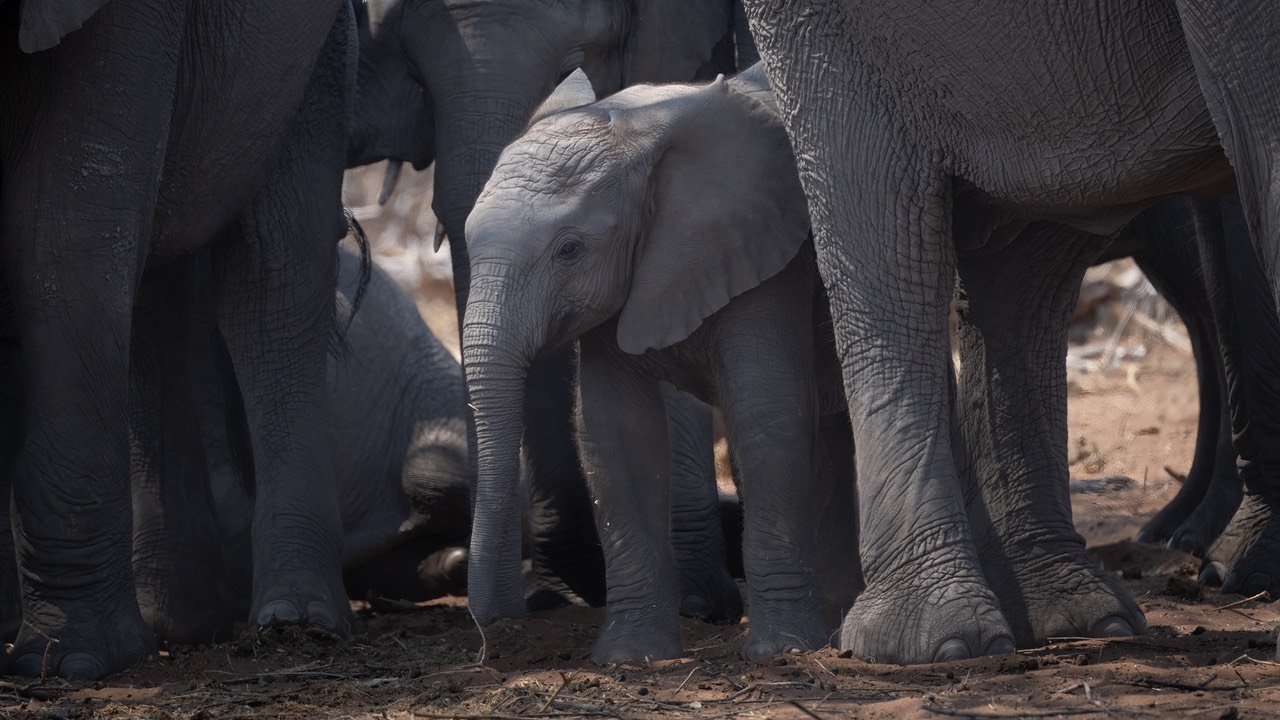
We also managed to get pretty close to a Kori Bustard that was hunting in the area.

Baby elephants in the clear and Kori Bustards close in and posing are not exactly common. So maybe things are becoming more eventful.
The boat ride itself started at 1:30 pm and lasted until after 4:00 pm. The ride itself I would call eventful. So what made the ride eventful where the rest of day sort of wasn’t. It was a 1/2 hour show from two bull elephant fighting while in the river itself. It wasn’t the most photogenic series I’ve ever taken of elephant but it certainly was entertaining, and long.

Botswana - Chobe - Serondella -20230930-1445-AnthonyMedici-Z90_7190.jpg
This above is a setup image of the elephants. The one on the far right left the water quickly. The other two then put on a wrestling match, complete with sound effects.
Here’s the one who left, getting out of the water…

And here’s a variety of images of the on-going water fight:
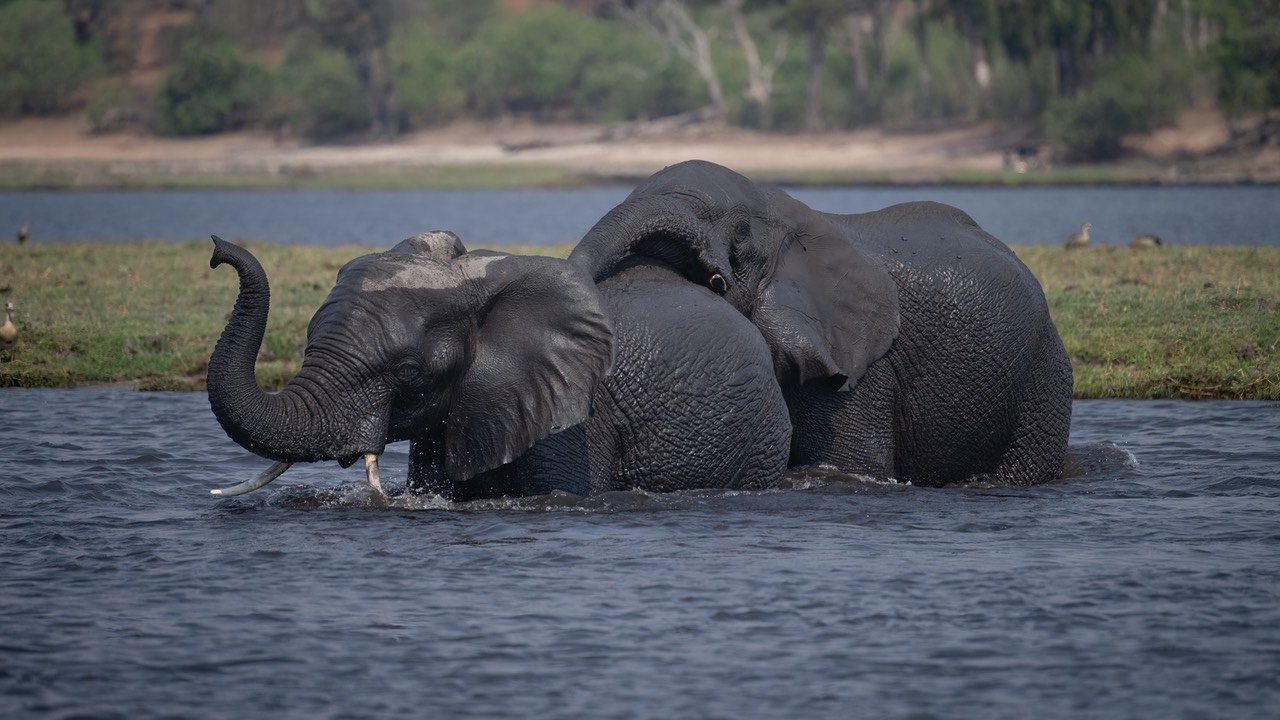


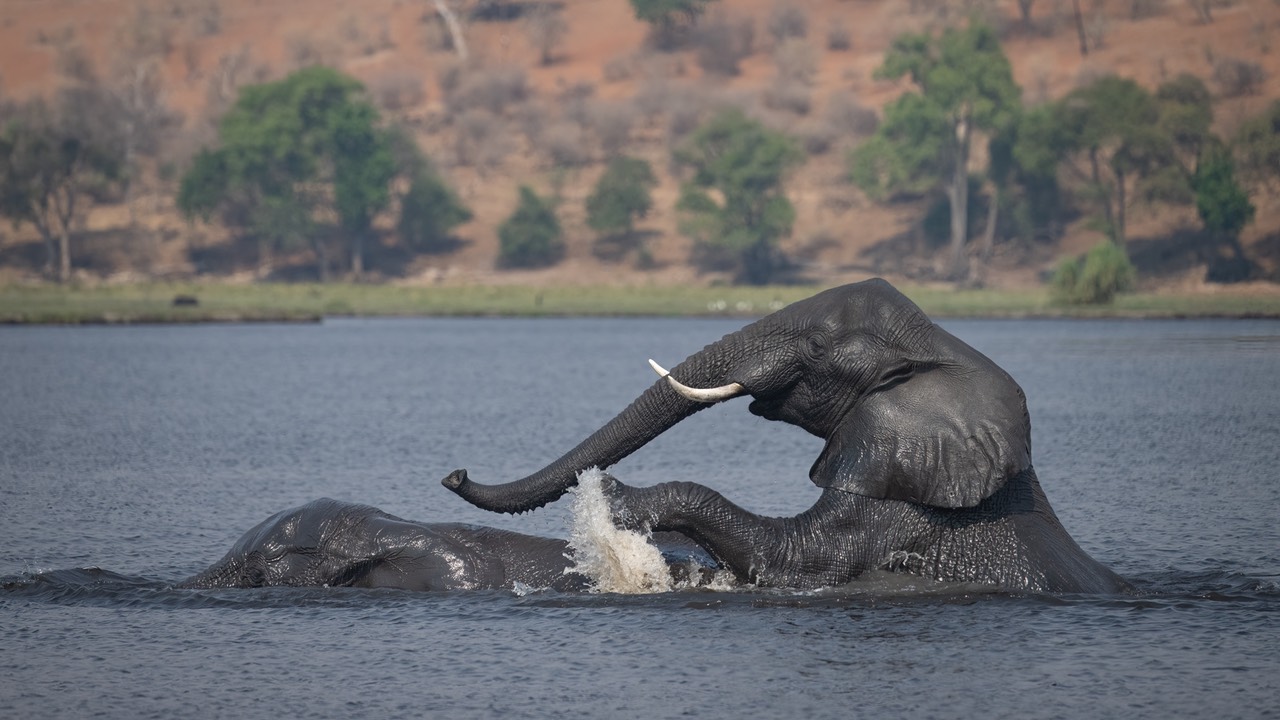
As with many things in Africa, size matters in a battle for dominance. But the littler (probably younger) guy put up a valiant and long effort.
The elephants weren’t the only things we saw while on the boat. Here are some images of some others that caught my eye.
A Nile Crocodile, for example,

and a nearby Monitor Lizard.
An African Fish Eagle waiting for the afternoon catch to swim by:
A Whiskered Tern:

An Openbill:
A Juvenile African Skimmer and an Adult African Skimmer (note how different the colorization gets):


A Nile Crocodile heading for the water.

A Pied Kingfisher with his afternoon catch:

Some White-throated Swallows
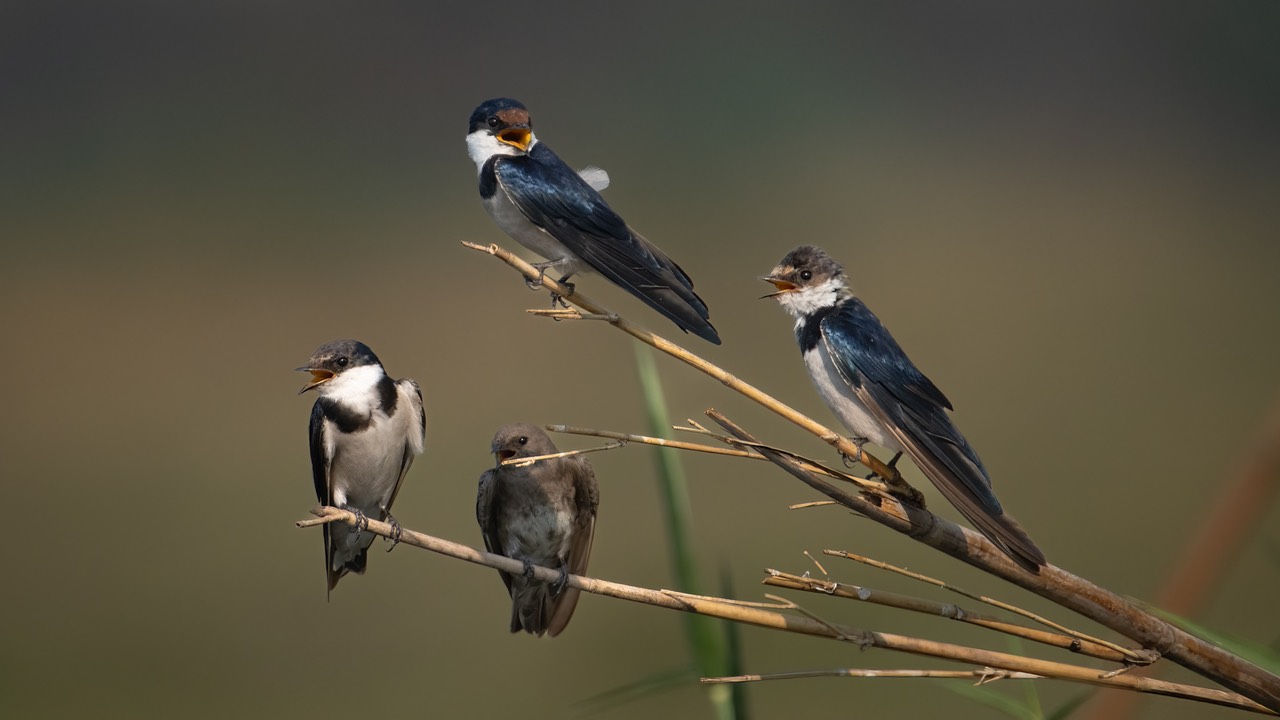
And a parting shot of an African Fish Eagle on his way to dinner:

If you haven't figured it out yet, being on a boat in the Chobe not only gives you a different perspective, but serves up an interesting array of birds and reptiles in addition to the usual mammals. The park regulates the hours we can be out in the channel, and we're always disappointed when that 4:30 quitting time rolls around, because there's so much more to photograph. Maybe I can convince Thom to have a morning and afternoon boat ride.
Bonus Video
One thing that I do every workshop is create a short video that tries to give a feel for what the trip was like, as well as who was on it. Sometimes I do more than one video, but with just me teaching and such a short, intense camp-to-camp schedule, I only had time to make a combined video this trip. As Apple would say, I'd like to show it to you:
Answers to the questions you have after watching the above:
- Yes, we really do drive the Land Cruisers through water (we have to at times).
- Yes, those are the planes we use (MackAir Cessna Caravans). Yes, you have to go through security (at least in Maun).
- Yes, even though it's the driest time of the year, you can see that the Okavango still has a lot of water in it.
- Yes, we really do carry maps and give lectures along the way. (I also carry a projector and screen, not shown.)
- No, the portraits were not done with a Plena (many were Nikon 70-180mm f/2.8).
- Yes, we always have more crew members than students. Your tent has an assigned steward who'll even keep it clean.
- Yes, we really do have a full time chef in the bush (and she's really, really good).
- Yes, all these images were taken by me on this trip, despite the fact that I was spending time teaching almost constantly.
- This presentation is made in Fotomagico on my MacBook Pro 14" as I travel, getting a little longer each night ;~). The actual presentation is in 4K, but through the wonders of Internet sharing, you'll likely only see it in FullHD.
No students were harmed in the making of this presentation. That I know of.
Day 10 and 11 — Victoria Falls Redux
written by Thom Hogan
We decided to break camp in Chobe early this morning, mostly to avoid potentially long lines at the border crossing into Zimbabwe, but also to give everyone more time at Victoria Falls. This turned out to be a good choice of timing, as there was no line when we arrived at the Zimbabwe Customs station, and we were able to process through quite quickly (for Africa).
We arrived at the historic Victoria Falls Hotel early, too, so rooms weren't quite ready. That gave us time for an early lunch and some story telling. I'm not going to tell the story yet, as that comes tomorrow for me (and a little later on this page), but I wanted everyone to know why this place was special to me, and to explain my mood.
Afternoon was dedicated to everyone enjoying the falls at their leisure. For dinner, we treated everyone to a full African buffet complete with native music and dancing. It was clear from the afternoon and the conversations that everyone was in "preparing for next travel" mode, so I didn't do any further instruction. I just showed them the video I had put together of our trip (see Bonus Video), and wished them a good night.
Day 11
I was up early this morning, taking a leisurely breakfast while listening to the background drone of the falls. All my students, though, are busy doing last minute packing and getting ready to leave the hotel this morning. Some are headed home, some are headed to another destination in Africa, and one is headed to a local project where they've volunteered for the next month.
After breakfast, I first made sure everyone got to their proper transport from the hotel, and then settled into what I told everyone I was going to do here at the falls: remember Galen Rowell.
I'm staying the extra day specifically for that purpose. I've never really taken a day to mourn the loss of one of the greatest adventure photographers, and I thought it appropriate to finally do so where we first met: Victoria Falls.
Even though that was now almost 30 years ago, being back here on the Zimbabwe side of the falls for the first time since that 1994 trip made it easy to remember my first encounter with the legend. What follows is the story I told the students yesterday...
Galen met us at the Victoria Falls Hotel for dinner, and then proceeded to give one of his inspiring photography lectures (complete with multiple slide projectors and a music sound track). Towards the end of the evening's instruction, he asked if anyone wanted to go photograph the sun coming up over the falls the following morning. Two of us said yes.
Oh, did I mention that Galen wanted to be in place by 5 am and that the park didn't open (then) until 7 am? By volunteering to photograph the sunrise we had also committed ourselves to climbing the park fence in the dark. All in order to get something like this:
The amusing bit was as I came out of the park through the regular gate at about 8am, I tried to pay my park entrance fee. "No, no, sir, you already paid when you went in." Hmm, how do I explain that I didn't do that? They were in complete denial that anyone might (or even could) jump the fence—it was a very tall fence, so I could see how they might think that—and wouldn't believe my story that I had snuck in. To this day I still owe Zimbabwe money. Amazingly, inflation would make that about US$30 today, despite all the issues that Zimbabwe has had with deflation.
After a late breakfast with Galen, we headed back out, this time paying for entering the park (so maybe I don't owe them anything after all ;~). We first headed to the Devil's Cataract, where we could easily see this rainbow (pardon the poor film scans in this section; I really need to redo them all now that I know what I'm doing):
Galen turned to me and asked: "So, do you know how to find rainbows?"
Uh, in front of me?
But it turned out he was serious and in full on teaching mode. The simplified version is this: look for the shadow of your head and go out about 45° (anyone can find 45°). There's the rainbow. In reality, the primary bow tends to be at 42°, and there's more to it than that, but in practice, if the conditions warrant a rainbow and the sun's angle is at the right angle to produce it, that's all you have to do: find the shadow of your head and go out ~45°.
If you know anything about the overlook at Devil's Cataract, you also know that you're on an outcropping, and the ground slopes off to the right to another gorge you walked around. I remember looking at Galen as he told me the rule and saying, "but if that's correct, then there would be a rainbow right over here to my..." and I turned to my right and saw something like this (not the exact image, but illustrates the point):
Doh.
With that little bit of instruction done, Galen took off at one of his usual gallups and started working his way up the Zimbabwe side of the falls. This consists of a series of outcroppings that each jut towards the Zambian side, with a trail that runs fairly straight along the base of each.
I had an idea: I needed to use what Galen just taught me to get a photograph of Galen photographing a rainbow! Sure, the idea was simple enough, but the practical side of that was terrible. Galen was a very fast runner with tons of endurance, and he didn't stay put very long, just enough to take a photo before jogging off to his next location. So as I used the rule I had just learned to try to line up an image of Galen with a rainbow in front of him on the first jutting section, I'd just about get my position and framing right and...poof...off ran Galen to the next section.
So of course I'd run off to the section that Galen had just abandoned and try again to line up a new image given where he ended up on the next section and...poof...Galen was off again.
This continued down the entire stretch of trail before Galen finally got to last outcrop at the Zambezi River outlet. Fortunately, I knew this was my last chance, so I was running full out. And here's what I ended up with:
Pay attention to that drop off. You might notice you can climb a bit down it. I used that later in the day to try to avoid the park rangers at closing time, because to them closing time was 6pm sharp, and the actual sunset was something like 6:15pm. Thus, I hid myself down in that outcropping so as to take this image looking back towards Devil's Cataract:
Unfortunately, my tactic didn't work. I soon found myself with a ranger with a gun standing over me telling me that the park was closed, and I needed to leave. (Apparently, the Zambian side had radioed over that there was somebody stuck on the side of the cliff.)
So on my extra day in Victoria Falls, these were the type of stories I was remembering. I'm pretty sure Galen would have been proud of my end-of-day strategy: get the image first and foremost (as long as you're doing no harm to anyone or anything).
All of us who knew Galen miss him. I missed him a little more today.
Bonus: Here's a side of Galen you probably never saw. The following photo was taken when Galen's wife threw him a surprise 60th birthday party in Huarez in the year 2000 on one of our trips together. Many of the cake and party decorations somehow got transferred by Barbara to Galen. To this day, I still find some of those little colored confetti dots in my gear. As you might surmise, there was never a dull moment on a trip with Galen.
